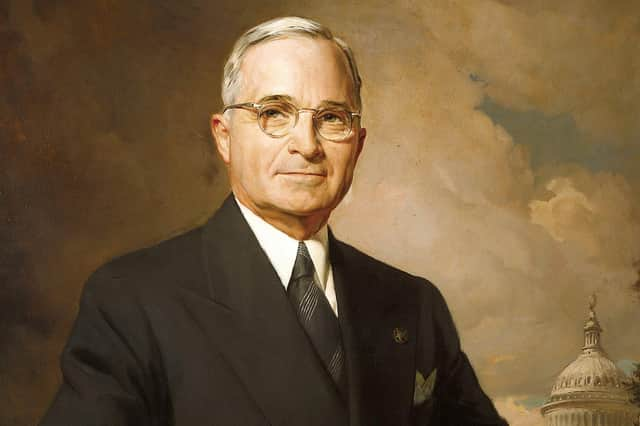Harry S Truman – is he the greatest of all Ulster-Scots US presidents?


On July 24, as the Potsdam Conference ended, Truman informed Stalin that he had acquired ‘a new weapon of unusual destructive force’. Because of the treachery of Klaus Fuchs, a member of the British scientific team, Stalin had already been briefed on July 18 by Beria, head of the NKVD (a precursor of the KGB), so that his reaction was muted.
Stalin, Molotov, the Soviet foreign minister, and Beria thought it hilarious when later they listened to recordings from the NKVD microphones of the conversation between Churchill and Truman when the former asked the latter how Stalin had taken the news. Given Stalin’s deadpan reaction, Truman replied that he thought Stalin had failed to understand.
Advertisement
Hide AdAdvertisement
Hide AdStalin was not impressed by Truman because he thought he was not in the same league as President Roosevelt and that he was ‘neither clever nor educated’.
Stalin professed to believe that Roosevelt was ‘a great statesman, a clever, educated, far-sighted and liberal leader who prolonged the life of capitalism …’
Stalin seriously underestimated ‘the little man’ of Ulster-Scots descent from Independence, Missouri.
Actually Truman was at least three inches taller than Stalin, a sensitive subject for Stalin after Truman apparently referred to him as ‘little squirt’.
Advertisement
Hide AdAdvertisement
Hide AdTruman may not have attended Harvard but he had a more realistic appraisal of Stalin and Soviet communism than FDR ever had. George Kennan, the advocate of ‘containment’ and the West’s greatest Kremlinologist, probably deserves most of the credit. He too was of Ulster-Scots heritage.
In a speech to Congress in March 1947 Truman identified the Soviet Union as America’s greatest foe, declaring that the world had to decide between two ways of life – freedom or totalitarianism.
Thus, Truman was responsible for the ‘Truman Doctrine’, the Marshall Plan, the Berlin Airlift, the formation of North Atlantic Treaty Organisation (Nato) and intervention in Korea to prevent North Korea’s bid to take over South Korea.
The creation of Nato could be viewed as the centrepiece of the political and military architecture which won the Cold War.
Advertisement
Hide AdAdvertisement
Hide AdThe cornerstone of the Nato treaty is and was Article 5 which states that an attack on one member of Nato is an attack on all of its members. Truman described the treaty as ‘a shield against aggression and the fear of aggression’.
A measure of its success is that Article 5 was never invoked during the Cold War. To date, it has been invoked only once – by the United States in response to the terrorist attacks of September 11, 2001.
The original signatories of the treaty were Belgium, Canada, Denmark, France, Iceland, Italy, Luxembourg, the Netherlands, Norway, Portugal, the United Kingdom and the United States.
The organisation currently has 30 member states. Following the acceptance of their applications for membership in June 2022, Finland and Sweden are anticipated to become the 31st and 32nd members.
Advertisement
Hide AdAdvertisement
Hide AdIn 1949 Nato represented a reversal of the long-standing US tradition of non-entanglement in Europe’s political and military affairs.
As Professor David Reynolds has explained: ‘… it was the first time the New World had made a peacetime military commitment to the Old. It was also a landmark in bipartisanship … built on cooperation between the Truman administration and moderate Republicans led by Senator Arthur Vandenberg of Michigan’.
It was also recognition that US disengagement from Europe played a major part in bringing about the two world wars, a point made by Truman at the treaty signing ceremony on April 4 1949.
Later in the year, President Truman proposed a military assistance programme, and the Mutual Defense Assistance Program passed the US Congress in October, appropriating some $1.4 billion for the purpose of building Western European defences.
Advertisement
Hide AdAdvertisement
Hide AdIn 1950-51 President Truman ‘put the O in Nato’ by converting the treaty from a diplomatic pact to a military alliance backed by four new US combat divisions and with the appointment of Dwight Eisenhower as commander.
Despite the Korean War, Truman continued to prioritise the US commitment to Europe ahead of Asia.
How do we evaluate the future of Nato? In 2023, with the seemingly inexorable rise of China, the US would appear to be reversing those priorities, a development evident to some observers over several decades.
At the Nato summit in 2018 President Trump threatened not to abide by Article 5 of the Nato treaty (admittedly subject to the proviso if Europe did not contribute more to its defence) and even to withdraw from Nato altogether.
Advertisement
Hide AdAdvertisement
Hide AdAlthough Trump did not withdraw the US from Nato, he perhaps undermined the credibility of Article 5, leading President Macron to declare that Nato was ‘brain dead’.
Perversely, by his invasion of Ukraine in February 2022 President Putin has breathed new life into Nato and has persuaded the European members to increase defence expenditure.
And what of Truman? In an interview in 1959 Truman said: ‘Some presidents were great and some of them weren’t. I can say that because I wasn’t one of the great presidents.’ He comforted himself with the observation: ‘Do your best, history will do the rest.’
History has been kind to Truman and deservedly so. Even so, he would be astonished by the praise historians have lavished upon him, especially for his foreign policy leadership. During his presidency Truman took many historically important decisions which went far to shape the second half of the 20th century.
Advertisement
Hide AdAdvertisement
Hide AdThough unpopular when the 33rd president left office in 1953, with lengthening perspective his reputation has grown enormously over the years, and he now consistently ranks among the top US presidents.
Andrew Jackson was the first of a long line of Ulster-Scots presidents and is often regarded as the greatest.
Jackson will always remain the first but arguably he is now surpassed by Truman as the greatest.